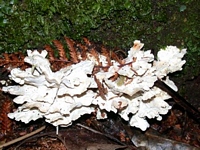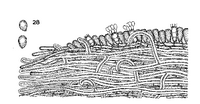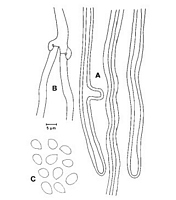|
 Ryvardenia campyla Ryvardenia campyla
SynonymsGrifola campyla
Grifola rosularis
Tyromyces falcatus
Polyporus campylus
Polyporus rosularis
Favolus hispidulus
Polyporus anthracophilus
Tyromyces campylus
BiostatusPresent in region - Indigenous. Non endemic
Images (click to enlarge)
Caption: Ryvardenia campyla
Owner: Nils Hallenberg | 
Caption: Tyromyces falcatus x 600, spores x 1200. Section through part of a dissepiment showing skeletal hyphae with peculiar sickle-shaped branches embedded among generative hyphae which are without clamp connections, clavate basidial type, and obovate spores.
Owner: Cunningham, G.H. | 
Caption: Fig. 5. Tyromyces falcatus. A, skeletal hyphae from the context; B, generative hyphae; C, spores.
From the type (PDD 15612). |
Article: Buchanan, P.K.; Ryvarden, L. (1988). Type studies in the Polyporaceae - 18. Species described by G.H. Cunningham. Mycotaxon 31(1): 1-38.
Notes: Cunningham (1965: 90) provided a good description of the species and transferred it to Grifola S.F. Gray because fruit-bodies usually consist of a cluster of imbricate pilei joined by a tuberous base. G. frondosa (Fr.) S.F. Gray, the type species, is similar to G. rosularis in having the same type of hyphal system and spores, although both spores and pores of G. frondosa are larger.
G. rosularis could be considered to belong in Tyromyces, which includes many species with imbricate basidiocarps, a monomitic hyphal system, and subglobose to ellipsoid, nonamyloid, nondextrinoid spores; T. pubescens (Fr.) Pilat is a representative example of this group. However, almost all Tyromyces species produce applanate basidiocarps on dead wood rather than semistipitate basidiocarps arising from a common base. Thus we maintain the species in Grifola.
Article: Gadgil, P.D. (in association with Dick, M.A.; Hood, I.A.; Pennycook, S.R.) (2005). Fungi on trees and shrubs in New Zealand. Fungi of New Zealand. Ngā Harore o Aotearoa 4: xi + 437 p. Hong Kong: Fungal Diversity Press.
Description: Type: Lignicolous Fungi; Description: Basidiomata annual, sometimes solitary but more usually compound, composed of many (up to 28) overlapping pilei, often forming a rosette, fleshy cartilaginous, brittle and easily snapped when young, attached by a common, broad lateral base. Pilei fan-shaped or spatulate, 15–25 mm wide, 1–5 mm thick, often merging laterally. Pileus surface delicately tomentose, white to cream, margin reddish brown, lobed. Pore surface plane, with a sterile border up to 2 mm wide, cream to light brown; pores large, 2–4 per mm. Context cream to light brown, up to 2 mm thick. Hyphal system dimitic. Basidiospores obovate, 5–8 × 4–5 μm, smooth, hyaline.
Distribution: Distribution: Bay of Plenty, Taupo, Gisborne, Nelson, Buller, Westland, Fiordland, North Canterbury, Otago Lakes.; 1st Record: Colenso (1887: as Favolus hispidus var.).
Article: Buchanan, P.K.; Ryvarden, L. (1988). Type studies in the Polyporaceae - 18. Species described by G.H. Cunningham. Mycotaxon 31(1): 1-38.
Notes: Accepted as Tyromyces falcatus.
The description by Cunningham of macroscopic characters is satisfactory, but there are misleading
statements about the microscopic characters. The septa of the generative hyphae are not simple, but
have large, conspicuous clamps. The basidiocarp is composed of mostly unbranched hyphae with
very thick walls. These vegetative hyphae were described by Cunningham as binding hyphae but
appear in the illustration (Cunningham, 1965: fig. 28) as skeletal hyphae. We interpret them as
skeletal hyphae with scattered side-branches, the side-branches not being as common or regular as
described by Cunningham. The thick hyphal walls often appear to be multilayered and are refractive
in KOH. T. falcatus has a harder texture than most other species in Tyromyces.
Article: Cunningham, G.H. (1948). New Zealand Polyporaceae. 3. The genus Polyporus. New Zealand Department of Scientific and Industrial Research, Plant Diseases Division, Bulletin 74: 39 p.
Description: Hymenophore annual, hard and horny though brittle, compound, rosulate, of numerous (5-15)
pilei united by a broad stem-like base to a common stroma. Pilei simple or branched, digitate,
spathulate, or urceolate, to 3 cm. x 3 cm. x 1-5 mm., attached by a broad base about the width
of the pileus; surface cream, becoming pallid ochre, irregular, radiately sulcate, finely
tomentose, cuticle to 100 µ thick, composed of densely woven hyphae arranged in a palisade
embedded in mucilage; margin reddish-brown, or concolorous, thin and horny, translucent,
much lobed or crenate, acute or bluntly rounded; hymenial surface decurrent, cream or pallid
ochre, darker peripherally, with or without a narrow sterile margin, dissepiments not toothed.
Context straw colour, 1-2 mm. thick, of radiately arranged hyphae, firm but brittle;
generative hyphae 6-8 µ thick, wall l µ, ribbon-like, lumen staining, sparsely branched,
septate, with large clamp connections. Pores straw colour in section, 1-1.5 mm. deep,
150-200 µ diameter, or 4-5 per mm.; dissepiments 50-200 µ thick, equal, of woven mainly
parallel hyphae, apex equal, finely velutinate. Basidial type clavate, basidia clavate, 14-16 x
5-7 µ, persistent. Spores broadly obovate, 4-5 x 3.5-4 µ, smooth, hyaline.
Habitat: Growing upon rotting logs or stumps.
Distribution: New Zealand.
Notes: Separated from P. anthracophilus and P. rosulatus by the palisade cuticle of the pileus,
smaller pores and differently shaped spores. The hymenophore is hard and horny, almost
cartilaginous, and pilei are firmly cemented together.
|